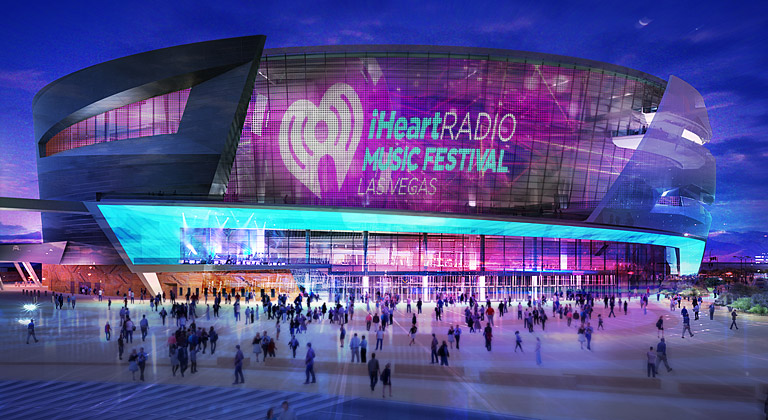U.S. Tennis Association Breaks Ground on Massive Campus
The U.S. Tennis Association (USTA) broke ground last week on a $60 million facility in Lake Nona, Florida. The USTA National Campus will reside on 63 acres and be home to sports-related businesses and organizations.
“Plans call for a tournament and league area with 24 clay courts and 16 hard courts; a University of Central Florida tennis area with 12 hard courts, elevated seating and facilities for 1,200 spectators; a Team USA area with eight hard courts and eight clay courts; and a player-development area with eight hard courts, eight red-clay courts and six covered courts,” Mary Shanklin reported for the Orlando Sentinel. “The space includes dormitories for 32 youth players and an area with eight courts that are shorter than regulation.”
The USTA will move its entire workforce to the new headquarters in Lake Nona.
“This new home for American tennis will truly be a game-changer for our sport,” said USTA Chairman of the Board and President Dave Haggerty in a statement. “This world-class facility will be an inclusive gathering place for American tennis and will allow us to impact our sport at every level, from the grassroots to the professional ranks.”
The facility is expected in fall 2016.
Tech Developed to Allow for Touching Holograms
Imagine putting on your virtual reality (VR) device and shooting hoops in your favorite arena. That scenario is one step closer thanks to technology developed by Ultrahaptics. The technology allows VR users to receive tactile sensations from 3-D objects floating in mid-air. It does so by using sound waves on your skin.
“If you go to a night club or a rock concert, you feel the music in your chest. And it’s the same principal—you feel the sound vibrating your chest,” Professor Sriram Subramanian told Reuters. “And instead of using the bass sounds, what we use is low frequency ultrasound—about 40 kHz—and that way we can target it at a precise point on your finger tip or on your palm, and then you feel the palm vibrate and it feels precise as well.”
The device is still in the prototype stage, but the company recently received a $900,000 investment that will help speed along development.
Subramanian said that as the touchless technology (think, waving your hand to turn off a light) trend continues, more people will want tactile feedback.
“You can see the object and maybe you can interact with this object visually, but you don’t feel anything,” Subramanian said. “What we’re offering is that missing feeling [of] these holographic objects. That I think is the crucial distinction as well as the advantage of what we’re offering. We’re not saying get rid of the holographic display. What we’re saying is, attach our system to it and then you can start feeling objects as well as seeing them. This gives you better finesse, control.”
More of the story can be found on Reuters.
(Image: Ultrahaptics)
The Arena That Watches You
When the Las Vegas arena opens next year, the audience won’t be the only thing watching an event—the venue will watch the audience, also, to generate ads.
“Cameras documenting an arena visitor’s gender and age, then computers digesting facial images to generate digital ads, music and food selections tailored to fit the crowd’s demographic composition,” Alan Snel reported for the Las Vegas Review-Journal.
The technology is part of a founding, decade-long sponsorship deal with Toshiba.
AEG spokesman Michael Roth told the newspaper that the data helps create a better, customized experience for guests.
“For example, if the data show a crowd’s skewing young (under 21) and female, it doesn’t pay to show digital beer and alcohol ads around the arena,” Roth told the paper. “But if there’s a boxing match and lots of men are in the arena, the beer spots would be rolled out.”
The technology can also recognize guests through tickets and smart watches if they post about an event on social media. But don’t worry, nothing’s being recorded.
(Image: Las Vegas arena)
Three Reasons to Love Data
Lt. Commander Data on Star Trek once wanted to become more than he was. The same can be said of abstract data. It’s nothing if it just sits there. It’s how you use it that matters, so I’d like to point you in the direction of a good article passed on to us from IAVM member Steve Schwartz, senior research policy analyst for Events DC and chair of our research committee. The article, “Six Reasons to Love Your Facilities Data,” was published in Facility Executive magazine and written by Lora Mays (quotes below are from her).
Here are the top three reasons you should love facilities data.
1. You Can’t Manage What You Can’t Measure
“Improvements based on data-driven decision making serves as a more effective way to manage the team effectively, in order to drive success across the team.”
2. Discover Weak Spots
“Through the analysis of key performance indicators, it can reveal gaps that are causing delays and previously misunderstood time investments.”
3. Know More About Costs and How to Reduce Them
“Reducing the time your team spends on breakdown maintenance and investing more time in preventive maintenance offers an opportunity for the facilities team to become more strategic.”
Please visit Facility Executive to learn about the other three reasons you should love data.
Why You Should Concentrate on the “Extra Miler”
The best way to improve your employees’ performances is to focus on motivating the “extra milers” in your organizations.
A new study out of the University of Iowa found that employees function better when team members who goes beyond their job descriptions—the extra milers—are in a central position in the workflow.
“The extra miler has more of an influence in the center because they have more contact with other workers and because others can see what they’re doing,” said lead researcher Ning Li, professor of management sciences in the Tippie College of Business. “Through this role modeling, everyone on the team becomes better. If the extra miler is on the periphery, they don’t come into contact with as many team members and nobody notices them.”
After studying 87 teams with an average number of eight members per team, the researchers found that extra milers showed two distinct behaviors—helping and voice.
“Helping behavior means they physically assist other workers with their jobs, for instance, if they’re overwhelmed, or out sick,” Li said. “Voice behavior means they provide leadership by speaking up to make constructive changes that provide a better workflow, or work with management to make the job easier for the workers.”
Li said the study suggest managers should organize their teams based on members’ individual characteristics and not treat employees as interchangeable.
“It demonstrates that you need to pay attention to key players in a team because some of them are more important than others,” Li said. “Management can rely on the extra miler to have a positive impact on the team and know that person will help to manage the team.”
(Image: Simon Chorley/Creative Commons)
Do you want to receive a Front Row News weekly digest?
Categories
- Allied (861)
- Architecture (147)
- Arenas (747)
- Career (897)
- Convention Centers (895)
- Education (623)
- Events (1,544)
- Food & Beverage (193)
- Foundation (113)
- Guest Experience (1,496)
- Industry News (2,270)
- Leadership (1,888)
- Marketing (150)
- Membership (2,000)
- Music (213)
- Performing Arts Centers (454)
- Professional Development (409)
- Research (127)
- Safety & Security (442)
- Sports (763)
- Stadiums (608)
- Student (159)
- Technology (516)
- Ticketing (92)
- Touring (82)
- Trends (364)
- Uncategorized (743)
- Universities (218)
- Video (25)
- Young Professional (198)
Twitter Feed
- Twitter feed loading
Recent Posts
- Venuworks and ATG Entertainment Selected to Manage Fresno Convention and Entertainment Center
- Seattle Convention Center Announces Strategic Leadership Appointment and Growth Initiatives for 2026
- Peggy Daidakis Humbly Made Convention Center History
- Welcome to Our Newest Members
- New Member Benefit! IAVM Partners with Advantage Training to Elevate Staff Readiness and Guest Experience
Categories
- Allied
- Architecture
- Arenas
- Career
- Convention Centers
- Education
- Events
- Food & Beverage
- Foundation
- Guest Experience
- Industry News
- Leadership
- Marketing
- Membership
- Music
- Performing Arts Centers
- Professional Development
- Research
- Safety & Security
- Sports
- Stadiums
- Student
- Technology
- Ticketing
- Touring
- Trends
- Uncategorized
- Universities
- Video
- Young Professional
Archives
- December 2025
- November 2025
- October 2025
- September 2025
- August 2025
- July 2025
- June 2025
- May 2025
- April 2025
- March 2025
- February 2025
- January 2025
- December 2024
- November 2024
- October 2024
- September 2024
- August 2024
- July 2024
- June 2024
- May 2024
- April 2024
- March 2024
- February 2024
- January 2024
- December 2023
- November 2023
- October 2023
- September 2023
- August 2023
- July 2023
- June 2023
- May 2023
- April 2023
- March 2023
- February 2023
- January 2023
- December 2022
- November 2022
- October 2022
- September 2022
- August 2022
- July 2022
- June 2022
- May 2022
- April 2022
- March 2022
- February 2022
- January 2022
- December 2021
- November 2021
- October 2021
- September 2021
- August 2021
- July 2021
- June 2021
- May 2021
- April 2021
- March 2021
- February 2021
- January 2021
- December 2020
- November 2020
- October 2020
- September 2020
- August 2020
- July 2020
- June 2020
- May 2020
- April 2020
- March 2020
- February 2020
- January 2020
- December 2019
- November 2019
- October 2019
- September 2019
- August 2019
- July 2019
- June 2019
- May 2019
- April 2019
- March 2019
- February 2019
- January 2019
- December 2018
- November 2018
- October 2018
- September 2018
- August 2018
- July 2018
- June 2018
- May 2018
- April 2018
- March 2018
- February 2018
- January 2018
- December 2017
- November 2017
- October 2017
- September 2017
- August 2017
- July 2017
- June 2017
- May 2017
- April 2017
- March 2017
- February 2017
- January 2017
- December 2016
- November 2016
- October 2016
- September 2016
- August 2016
- July 2016
- June 2016
- May 2016
- April 2016
- March 2016
- February 2016
- January 2016
- December 2015
- November 2015
- October 2015
- September 2015
- August 2015
- July 2015
- June 2015
- May 2015
- April 2015
- March 2015
- February 2015
- January 2015
- December 2014
- November 2014
- October 2014
- September 2014
- August 2014
- July 2014
- June 2014
- May 2014
- April 2014
- March 2014
- February 2014
- January 2014
- December 2013
- November 2013
- October 2013
- September 2013
- August 2013
- July 2013
- June 2013
- May 2013
- April 2013
- March 2013
- February 2013
- January 2013
- May 2012
- March 2012
- December 2011
- November 2011
- October 2011
Recent Comments
- Frank Bradshaw, Ph.D., CVE on John Meyer, CVE, a Tireless Advocate of Certification for Venue Professionals, Has Died
- Neil Sulkes on Hilary Hartung, Friend to Many in Venue Marketing, Has Left Us
- Jason Parker, CVE on The Devastation of Hurricane Helene and How We Can Support One Another
- Larry Perkins on Touhey Testifies Against Speculative Ticketing Before Congressional Subcommittee
- Peter Secord on Major Players for Planned Elkhart Amphitheater Were in the Mix at VenueConnect





